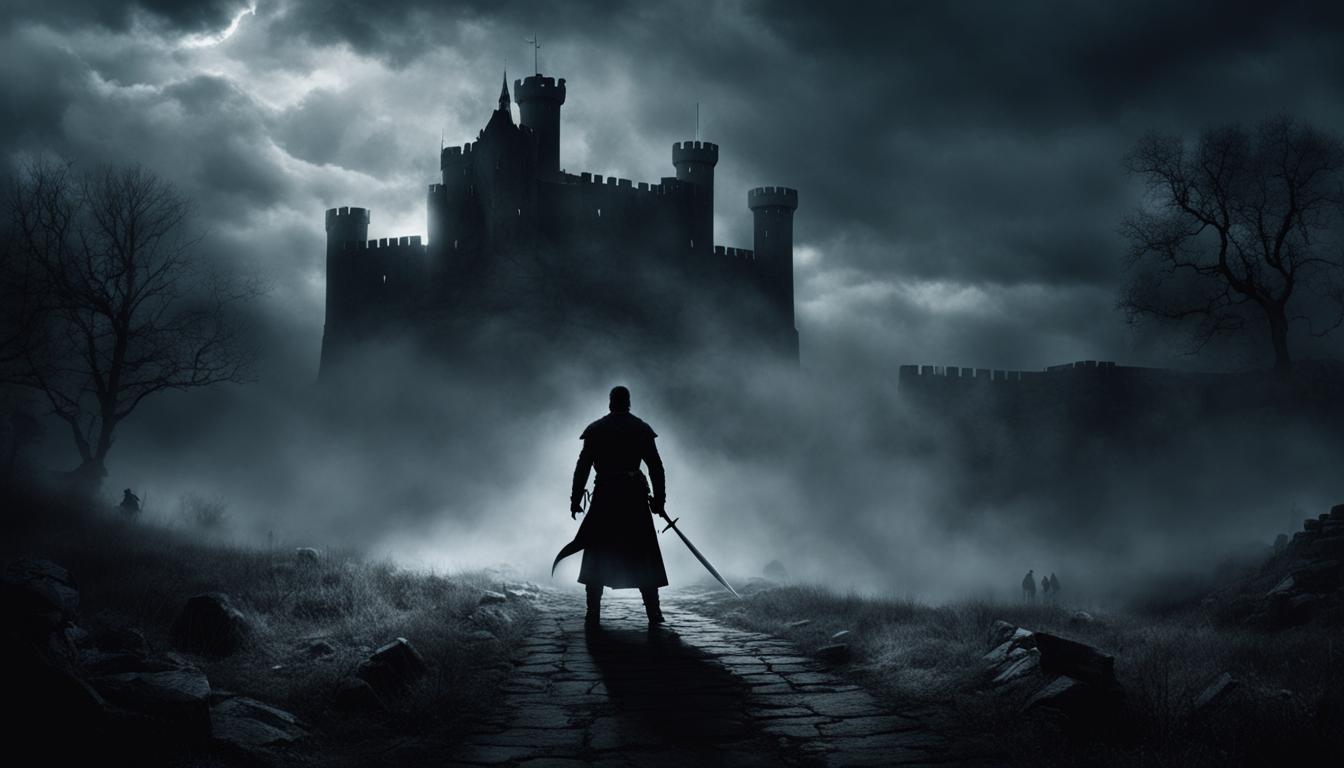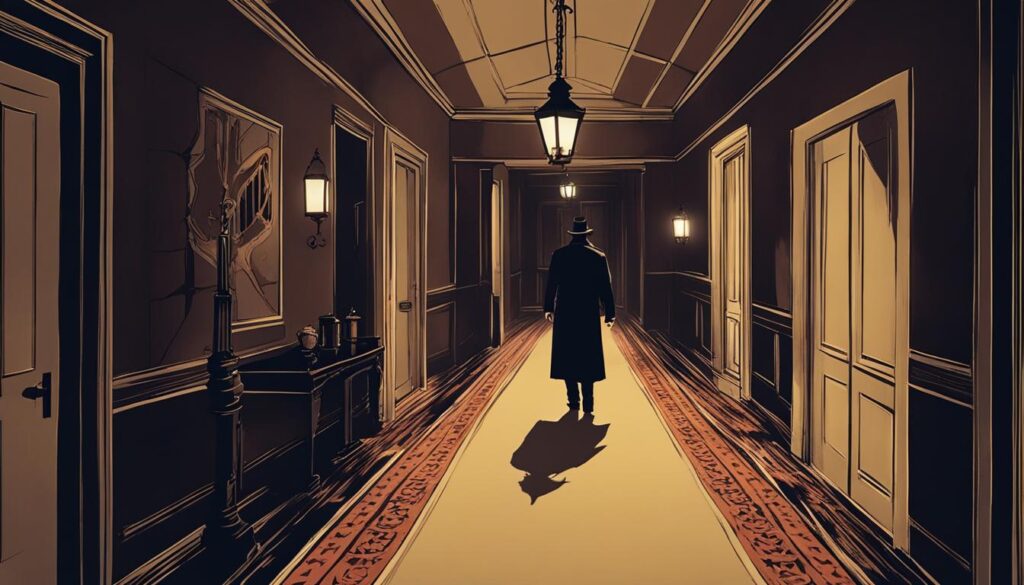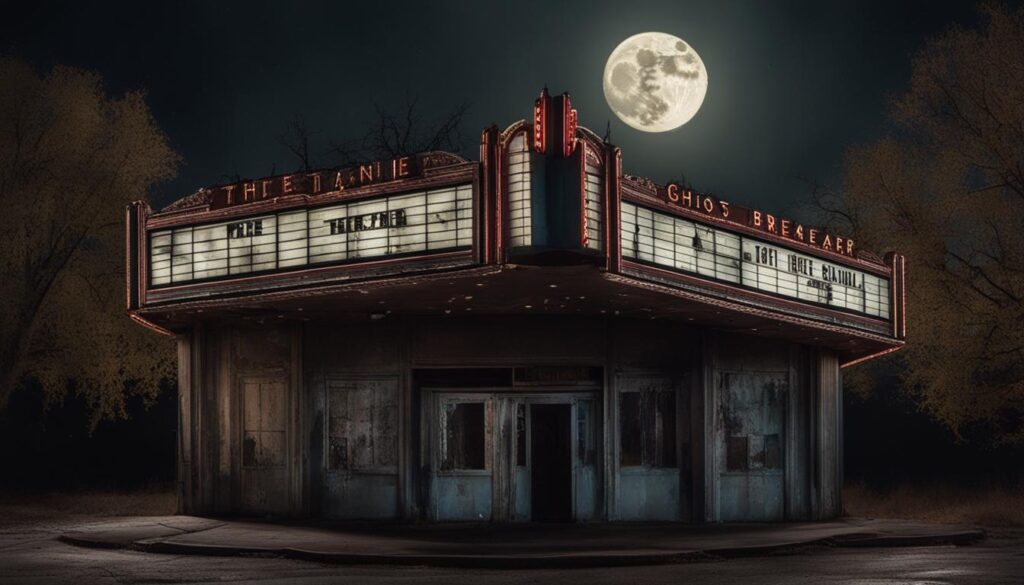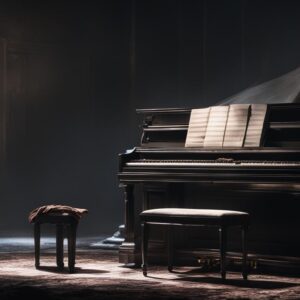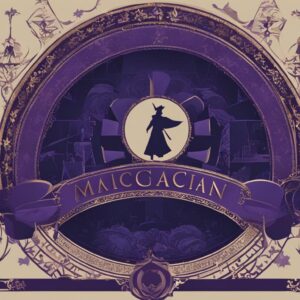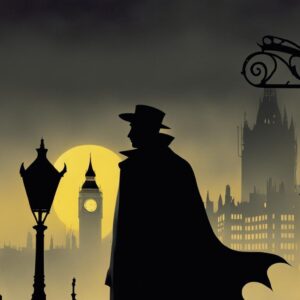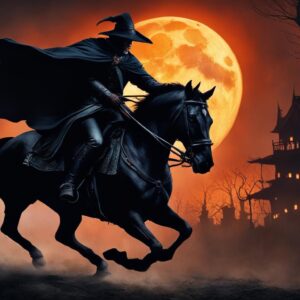As a lover of vintage cinema, I have always been intrigued by the magic and allure of silent films. One classic that stands out is “The Ghost Breaker” (1922), a hauntingly entertaining silent horror movie that combines elements of suspense, comedy, and the supernatural. This early American film takes viewers on a thrilling journey through a haunted house, captivating audiences with its unique blend of horror and humor.
Directed by Alfred E. Green and starring Wallace Reid in one of his final screen roles, “The Ghost Breaker” is based on the 1909 play of the same name by Paul Dickey and Charles W. Goddard. Although the film is considered lost, its influence on the horror genre and American cinema as a whole cannot be denied. It paved the way for future haunted house movies and left a lasting impact on the world of vintage horror.
Key Takeaways:
- “The Ghost Breaker” (1922) is a silent film that combines horror and comedy in a unique and captivating way.
- Directed by Alfred E. Green and starring Wallace Reid, the film follows the story of a haunted house and the supernatural events that unfold within.
- Although the film is considered lost, its influence on the horror genre and American cinema is significant.
- “The Ghost Breaker” paved the way for future haunted house movies, showcasing the enduring appeal of vintage horror.
- This classic silent film provides a glimpse into the early days of American cinema and the artistry of filmmakers at the time.
The 1922 Version of The Ghost Breaker
The 1922 version of The Ghost Breaker is now considered a lost film. Directed by Alfred E. Green, it starred Wallace Reid in one of his last screen roles. The film was based on the 1909 play The Ghost Breaker and had previously been released on film in 1914. Two of the actors in the 1922 film, Snitz Edwards and Arthur Edmund Carewe, later appeared together in the 1925 film The Phantom of the Opera. Mervyn LeRoy and Richard Arlen, who were uncredited “ghosts” in the cast, also went on to successful film careers.
Although The Ghost Breaker (1922) is no longer available for viewing, its significance in the history of haunted house movies and its contribution to the career of Wallace Reid cannot be overlooked. The film captivated audiences with its blend of horror and comedy, a unique combination that continues to entertain viewers to this day.
While we may never have the chance to experience the 1922 version of The Ghost Breaker, its influence can still be felt in the subsequent adaptations and remakes that followed. The film laid the foundation for future haunted house movies and showcased the talents of its director, Alfred E. Green, and star, Wallace Reid. Although lost to time, The Ghost Breaker (1922) remains a significant piece of cinematic history.
Lost Film: The Ghost Breaker (1922)
| Director | Alfred E. Green |
|---|---|
| Starring | Wallace Reid |
| Genre | Horror Comedy |
| Status | Lost Film |
The Legacy of The Ghost Breaker: Remakes and their Influence
Remakes have always played a significant role in the world of cinema, allowing filmmakers to reinterpret and reimagine beloved stories for new generations. The Ghost Breaker, a classic silent horror comedy from 1922, has seen its fair share of remakes that have brought new life to the haunted house theme. Two notable remakes of The Ghost Breaker are The Ghost Breakers (1940) and Scared Stiff (1953), both showcasing the comedic talents of Bob Hope, Paulette Goddard, Jerry Lewis, and Dean Martin.
In The Ghost Breakers (1940), Bob Hope and Paulette Goddard take on the lead roles and infuse the story with their signature humor. The film revitalizes the haunted house theme with a comedic twist, providing audiences with a fresh and entertaining experience. Similarly, Scared Stiff (1953) stars the iconic duo of Jerry Lewis and Dean Martin, adding their unique comedic flair to the haunted house genre. These remakes not only pay homage to the original film but also introduce the story to new audiences who may not have experienced the silent film version.
Each remake of The Ghost Breaker brings its own interpretation and style to the story, showcasing the versatility and enduring appeal of the haunted house theme. These films serve as a testament to the timeless nature of The Ghost Breaker and its ability to inspire future generations of filmmakers. Through their remakes, Bob Hope, Paulette Goddard, Jerry Lewis, and Dean Martin have not only honored the legacy of the original film but also left their own indelible mark on the haunted house genre.
Table:
| Remake | Year | Lead Actors |
|---|---|---|
| The Ghost Breakers | 1940 | Bob Hope, Paulette Goddard |
| Scared Stiff | 1953 | Jerry Lewis, Dean Martin |
The Plot of The Ghost Breaker (1922)
The Ghost Breaker (1922) follows the story of Warren Jarvis (Wallace Reid) and his manservant Rusty Snow (Walter Hiers) as they help a young heiress named Maria Theresa (Lila Lee) rid her father’s mansion of ghosts. However, it is revealed that the ghosts are actually fake, created by the Duke D’Alba to scare Maria Theresa away so he can steal her father’s hidden gold. The film combines elements of horror and comedy, adding to the suspense and entertainment value.
In this thrilling silent film, Warren and Rusty embark on a mission to solve the mystery and protect Maria Theresa from harm. Along their journey, they encounter hidden passageways, secret rooms, and unexpected twists. The film’s suspenseful atmosphere is enhanced by the haunting visuals and the eerie presence of ghosts lurking in the mansion’s shadows.
The chemistry between Wallace Reid and Lila Lee brings depth to their characters and adds emotional resonance to the plot. Their performances captivate the audience, making us root for their success in unraveling the secrets of the haunted mansion. The Ghost Breaker (1922) is a perfect blend of horror and comedy, providing both thrills and laughs throughout the film.
The Ghost Breaker (1922) Quote:
“There’s something strange going on in this mansion, and it’s up to us to uncover the truth and protect Maria Theresa!” – Warren Jarvis
The plot of The Ghost Breaker (1922) keeps viewers on the edge of their seats as they eagerly await the resolution of the mystery. It is a testament to the enduring power of storytelling and the timeless appeal of the haunted house genre. The film serves as a classic example of early American cinema, showcasing the creativity and innovation of filmmakers during that era.
The Ghost Breaker (1914) and The Ghost Breaker (1922) Comparison
When exploring the history of The Ghost Breaker, it’s important to examine the two film adaptations that were made: The Ghost Breaker (1914) and The Ghost Breaker (1922). The first film, released in 1914, was directed by Cecil B. DeMille and Oscar Apfel. Unfortunately, this silent film version is now considered lost, making it impossible to compare it directly to the 1922 adaptation. However, both films share the same name and are based on the 1909 play The Ghost Breaker.
The Ghost Breaker (1922) was directed by Alfred E. Green and starred Wallace Reid and Lila Lee in the lead roles. It followed the story of Warren Jarvis and his manservant Rusty Snow as they help a young heiress named Maria Theresa rid her father’s mansion of ghosts. However, they soon discover that the ghosts are fake and part of a scheme by the Duke D’Alba to steal her father’s hidden gold. While the 1922 film is also considered lost, it is important to note the presence of notable actors such as Wallace Reid and Lila Lee.
“The Ghost Breaker (1922) was a significant adaptation of the play, featuring Wallace Reid and Lila Lee in memorable performances. While the film is lost, its impact on the haunted house genre cannot be ignored.” – Film Historian
Although we can’t directly compare the two adaptations due to the loss of the 1914 film, it is clear that The Ghost Breaker story resonated with audiences and inspired multiple adaptations. The 1922 version expanded on the play’s plot and featured notable actors, making it a significant film for its time. The Ghost Breaker (1914) and The Ghost Breaker (1922) are both important pieces of cinematic history, showcasing the early exploration of the haunted house theme on the big screen.
| The Ghost Breaker (1914) | The Ghost Breaker (1922) |
|---|---|
| Directed by Cecil B. DeMille and Oscar Apfel | Directed by Alfred E. Green |
| Starring Cecil B. DeMille and Oscar Apfel | Starring Wallace Reid and Lila Lee |
| Losing the original film creates curiosity about the portrayal of the haunted house theme and the character dynamics in this version. | The 1922 adaptation expanded on the play’s plot and showcased notable actors, making it a significant film for its time. |
While we may never see the 1914 adaptation of The Ghost Breaker, its existence and influence cannot be forgotten. The 1922 version built upon the success of the play and established itself as a notable film, even if it is lost to us today. Both films hold a special place in the history of the haunted house genre, paving the way for future adaptations and influencing the way the theme is portrayed on screen.
The Ghost Breakers (1940)
The Ghost Breakers (1940) is a comedy horror film that stars Bob Hope and Paulette Goddard. It is a remake of the 1922 film, The Ghost Breaker, and adds a humorous twist to the haunted house theme. The film follows the adventures of Larry Lawrence (Bob Hope) as he helps Mary Carter (Paulette Goddard) rid her inherited mansion of ghosts.
The Ghost Breakers (1940) showcases the comedic talents of Bob Hope and Paulette Goddard, who bring their signature humor and charm to the film. The comedic elements add a lighthearted touch to the suspenseful story, creating an entertaining and enjoyable viewing experience. The film’s blend of comedy and horror creates a unique atmosphere that keeps audiences engaged and on the edge of their seats.
With its witty dialogue, comedic timing, and memorable performances, The Ghost Breakers (1940) has become a beloved classic in the comedy horror genre. It remains a testament to the enduring appeal of the haunted house theme and the talents of Bob Hope and Paulette Goddard. The film continues to entertain audiences with its timeless humor and spooky thrills, making it a must-watch for fans of vintage cinema and classic horror films.
| Directed by | George Marshall |
|---|---|
| Produced by | Arthur Hornblow Jr. |
| Written by | Walter DeLeon |
| Starring | Bob Hope, Paulette Goddard |
| Music by | Ernst Toch |
| Cinematography | Charles Lang |
| Production Company | Paramount Pictures |
| Distributed by | Paramount Pictures |
| Release date | June 21, 1940 |
| Running time | 85 minutes |
| Country | United States |
| Language | English |
Scared Stiff (1953)
Scared Stiff (1953) is a comedy horror film that showcases the comedic talents of Jerry Lewis and Dean Martin. In this remake of The Ghost Breaker, the duo brings their signature style and humor to the haunted house genre. The film follows nightclub entertainer Larry Todd (Dean Martin) and his friend Myron Mertz (Jerry Lewis) as they find themselves embroiled in a mysterious adventure while performing in Casablanca.
Scared Stiff adds a comedic twist to the suspenseful elements of the story, creating a unique blend of laughter and intrigue. The film’s hilarious antics and comedic timing showcase the dynamic chemistry between Jerry Lewis and Dean Martin, making it a delightful watch for fans of classic comedy.
“Ghosts don’t go around walking. They float. That’s what I call floating.” – Larry Todd (Dean Martin)
Scared Stiff is a prime example of how comedy can be seamlessly integrated into the horror genre. The film’s lighthearted approach to the haunted house theme provides a refreshing take on the genre, combining scares with laughter. With its memorable performances and entertaining storyline, Scared Stiff continues to bring joy and laughter to audiences decades after its release.
The Legacy of The Ghost Breaker
The Ghost Breaker is considered an influential film in the haunted house genre. It combines elements of horror and comedy in a unique way, setting the stage for future films in this genre. Despite being a silent film, The Ghost Breaker captured the attention of audiences with its mixture of suspense and humor. The film’s influence can be seen in later adaptations and remakes, which kept the haunted house theme alive and introduced new generations to the story.
A Film Ahead of Its Time
The Ghost Breaker, released in 1922, was ahead of its time in blending horror and comedy. At a time when most horror films were strictly serious and intense, this film dared to incorporate comedic elements into the haunted house narrative. This unconventional approach resonated with audiences and paved the way for future horror comedies. The Ghost Breaker’s success demonstrated that a balance of scares and laughs could create a unique and entertaining cinematic experience.
Inspiring Future Filmmakers
The Ghost Breaker’s influence can be felt in the works of later filmmakers who were inspired by its innovative blend of horror and comedy. The film’s ability to seamlessly transition between suspenseful moments and comedic relief served as inspiration for future directors and writers. This influence is evident in the remakes and adaptations of The Ghost Breaker, which continued to explore the haunted house theme with a touch of humor. The legacy of The Ghost Breaker lives on in the countless films that followed its lead in the genre.
| Table 1: The Influence of The Ghost Breaker |
|---|
| The Ghost Breaker introduced a unique blend of horror and comedy to the haunted house genre. |
| The film’s success inspired filmmakers to explore similar themes and techniques in their own works. |
| The Ghost Breaker’s influence can be seen in the remakes and adaptations that followed, showcasing the enduring appeal of the haunted house narrative. |
The Ghost Breaker in American Cinema History
The Ghost Breaker holds a significant place in American cinema history as a silent film classic. It represents a unique blend of horror and comedy, a genre popular during the silent film era. The film showcases the technical advancements and storytelling techniques of the time, providing a glimpse into the early days of American cinema. The Ghost Breaker serves as a historical film that reflects the creative talents and innovations of the filmmakers and actors of that era.
As an influential film, The Ghost Breaker played a vital role in shaping the haunted house genre in American cinema. Its engaging storyline, suspenseful moments, and well-developed characters captivated audiences and inspired future filmmakers to explore similar themes and techniques in their own works. The film’s success paved the way for future adaptations and remakes, solidifying its status as a timeless classic in the history of American cinema.
With its vintage aesthetic and innovative storytelling, The Ghost Breaker exemplifies the charm and magic of early film. As audiences watch this silent horror comedy, they are transported back in time to experience the excitement and artistry of vintage cinema. The film’s enduring appeal lies in its ability to evoke emotions and captivate audiences, even decades after its original release. The Ghost Breaker continues to be remembered as a hallmark of American cinema and a testament to the creativity and talent of the filmmakers and actors of that era.
| Key Points | Details |
|---|---|
| American cinema | The Ghost Breaker holds a significant place in American cinema history. |
| Silent film era | The film showcases the technical advancements and storytelling techniques of the time. |
| Historical film | The Ghost Breaker serves as a historical film that reflects the creative talents and innovations of the filmmakers and actors of that era. |
| Classic horror film | The Ghost Breaker is an influential film that shaped the haunted house genre in American cinema. |
| Vintage cinema | The film exemplifies the charm and magic of early film, transporting viewers back in time to experience the excitement and artistry of vintage cinema. |
The Magic of Vintage Cinema
When it comes to the enchantment of vintage cinema, few films capture the essence and charm quite like The Ghost Breaker. As a silent film from the early days of filmmaking, it transports viewers back in time to experience the excitement and artistry of early film. Its vintage aesthetic, storytelling style, and creative techniques continue to captivate audiences today.
The allure of The Ghost Breaker lies in its ability to combine elements of horror and comedy in a way that captivates and entertains. The film’s blend of suspense, mystery, and supernatural elements creates a unique cinematic experience. Through its visual storytelling and compelling performances, The Ghost Breaker immerses viewers in a world of haunted houses and ghosts, inviting them to suspend disbelief and be swept away by the magic of early film.
One of the defining features of vintage cinema is its ability to evoke a sense of nostalgia and transport audiences to a different era. The Ghost Breaker epitomizes this appeal, allowing viewers to glimpse into the early days of American cinema and experience the technical advancements and storytelling techniques of the time. From the flickering black and white images to the atmospheric sets, each frame of the film is a testament to the artistry and creativity of the filmmakers and actors involved.
| Key elements of the magic of vintage cinema |
|---|
| Evokes a sense of nostalgia |
| Transports viewers to a different era |
| Represents the artistry and creativity of early filmmakers |
| Combines elements of horror and comedy |
| Immerses viewers in a world of suspense and entertainment |
The Enduring Appeal of Classic Horror Films
Classic horror films like The Ghost Breaker have stood the test of time due to their ability to evoke fear, suspense, and intrigue. The vintage aesthetic and storytelling techniques add to their lasting appeal, transporting audiences to a different era while keeping them engaged and entertained.
Despite the advancements in technology and storytelling, the allure of classic horror films remains strong. Films like The Ghost Breaker continue to captivate audiences with their timeless themes, masterful storytelling, and unforgettable characters. Whether it’s a haunted house or a supernatural phenomenon, the elements of mystery and suspense tap into our deepest fears and leave a lasting impression.
As we delve into the world of vintage cinema with films like The Ghost Breaker, we are reminded of the magic that cinema holds. It is a medium that has the power to transport us to different times, evoke emotions, and keep us entertained. The enduring appeal of classic horror films like The Ghost Breaker serves as a testament to the lasting impact and fascination that these films have on audiences.
The Haunted House Theme in Film
The haunted house theme has been a recurring motif in film, captivating audiences with its mixture of suspense, mystery, and supernatural elements. One notable example of this theme is the classic silent film, The Ghost Breaker. Released in 1922, The Ghost Breaker combines elements of horror and comedy, creating a unique and entertaining experience for viewers.
In the film, the protagonist, Warren Jarvis, and his faithful manservant, Rusty Snow, embark on a mission to help a young heiress rid her father’s mansion of ghosts. However, they soon discover that the ghosts are not what they seem, ultimately leading them on a thrilling and humorous adventure.
This blend of horror and comedy in The Ghost Breaker adds a unique twist to the haunted house genre. It offers a multifaceted viewing experience that keeps audiences on the edge of their seats while also providing moments of comedic relief. This combination of elements has contributed to the enduring appeal of the film and its continued influence on future works within the genre.
| Key Elements of The Ghost Breaker | Impact on the Genre |
|---|---|
| A haunted mansion | Set the stage for future haunted house films |
| Supernatural occurrences | Inspired filmmakers to explore paranormal themes |
| Suspenseful storytelling | Influenced the pacing and narrative structure of subsequent films |
| Humorous moments | Added a comedic twist to the genre, appealing to broader audiences |
The Enduring Appeal of Classic Horror Films
Classic horror films have a timeless allure that continues to captivate audiences around the world. One such film that holds a special place in the genre is “The Ghost Breaker.” As a vintage horror movie, it combines elements of suspense, mystery, and the supernatural, creating a thrilling cinematic experience.
What sets “The Ghost Breaker” apart is its unique blend of horror and comedy. The film strikes a delicate balance between frightful moments and lighthearted humor, creating an entertaining and engaging story. This classic horror film showcases the creative vision of the filmmakers and the exceptional performances of the cast.
With its vintage aesthetic and storytelling techniques, “The Ghost Breaker” transports viewers back to a bygone era of cinema. It captures the essence of early film and offers a glimpse into the artistry and innovation of the silent film era. The enduring appeal of this haunted house movie is a testament to its lasting impact on the genre.
| Key Elements of “The Ghost Breaker” | Key Elements of “The Ghost Breaker” |
|---|---|
| Vintage aesthetic | Engaging storytelling |
| Blend of horror and comedy | Timeless appeal |
| Supernatural elements | Captivating performances |
As fans of classic horror films, we are drawn to the enduring appeal of “The Ghost Breaker” and its vintage charm. This haunting tale continues to captivate audiences, reminding us of the magic that movies can create. It serves as a reminder of the rich history and lasting impact of classic horror films in the world of cinema.
The Influence of The Ghost Breaker on Future Films
The Ghost Breaker, with its unique blend of horror and comedy, has had a significant influence on future films within the haunted house genre. This influential film, although now lost, continues to inspire filmmakers to explore similar themes and techniques in their own works. The Ghost Breaker’s success and enduring popularity have solidified its status as a classic horror film.
The film’s combination of suspense and humor creates a captivating viewing experience, and its influence can be seen in subsequent adaptations and remakes. Filmmakers have been drawn to the haunted house theme, finding inspiration in the way The Ghost Breaker balanced supernatural elements with comedic moments. This influential film paved the way for future movies in the genre, showcasing the enduring appeal of haunted house stories.
By blending horror and comedy, The Ghost Breaker captured the attention of audiences and demonstrated the creative potential of combining different genres. This innovative approach to storytelling influenced filmmakers to explore new ways to entertain and engage viewers. The Ghost Breaker’s impact on future films is a testament to its status as an influential and timeless classic in the world of cinema.
Overall, The Ghost Breaker’s influence on future films within the haunted house genre cannot be underestimated. Its unique blend of horror and comedy, along with its enduring popularity, has solidified its status as an influential classic. Filmmakers continue to draw inspiration from this timeless film, showcasing the lasting impact and fascination it holds for audiences.
Conclusion
The Ghost Breaker (1922) is a remarkable silent film that continues to hold its place as a classic horror movie in vintage cinema. With its unique combination of horror and comedy, this haunted house film has captivated audiences for decades. The talented filmmakers and actors involved in the production have left a lasting impact on American cinema.
As I explored the story of The Ghost Breaker, I discovered its influence on future films within the genre. The blend of suspenseful storytelling and the haunted house theme has inspired filmmakers to explore similar themes and techniques in their own works. This film’s enduring popularity is a testament to its ability to evoke fear, intrigue, and entertainment.
The Ghost Breaker (1922) transports viewers back to the early days of silent films, showcasing the magic and allure of vintage cinema. Its vintage aesthetic, combined with creative storytelling techniques, provides a unique and captivating experience. This classic horror film remains an important part of American cinema history.
In conclusion, The Ghost Breaker (1922) stands as a testament to the timeless appeal of silent films, haunted house movies, and classic horror films. Through its unique blend of horror and comedy, this vintage gem continues to entertain and inspire audiences, cementing its place as a beloved cinematic treasure.
FAQ
Is The Ghost Breaker (1922) considered a lost film?
Yes, the 1922 version of The Ghost Breaker is considered lost.
Who directed The Ghost Breaker (1922)?
The Ghost Breaker (1922) was directed by Alfred E. Green.
Who starred in The Ghost Breaker (1922)?
Wallace Reid starred in The Ghost Breaker (1922) in one of his last screen roles.
What play was The Ghost Breaker (1922) based on?
The Ghost Breaker (1922) was based on the 1909 play The Ghost Breaker by Paul Dickey and Charles W. Goddard.
Who appeared together in both The Ghost Breaker (1922) and The Phantom of the Opera (1925)?
Snitz Edwards and Arthur Edmund Carewe appeared together in both The Ghost Breaker (1922) and The Phantom of the Opera (1925).
Who were the uncredited actors in The Ghost Breaker (1922) who later had successful film careers?
Mervyn LeRoy and Richard Arlen were uncredited “ghosts” in The Ghost Breaker (1922) and went on to have successful film careers.
What remakes were made of The Ghost Breaker?
The Ghost Breaker was remade as The Ghost Breakers (1940) and as Scared Stiff (1953).
Who starred in The Ghost Breakers (1940)?
Bob Hope and Paulette Goddard starred in The Ghost Breakers (1940).
Who starred in Scared Stiff (1953)?
Jerry Lewis and Dean Martin starred in Scared Stiff (1953).
What is the plot of The Ghost Breaker (1922)?
The Ghost Breaker (1922) follows Warren Jarvis and his manservant Rusty Snow as they help a young heiress rid her father’s mansion of fake ghosts created by the Duke D’Alba.
How does The Ghost Breaker (1922) compare to the 1914 version?
The Ghost Breaker (1922) and The Ghost Breaker (1914) have different directors and cast members, with Wallace Reid and Lila Lee starring in the 1922 version.
What is The Ghost Breakers (1940) about?
The Ghost Breakers (1940) is a comedy horror film starring Bob Hope and Paulette Goddard, following Larry Lawrence as he helps Mary Carter rid her inherited mansion of ghosts.
What is Scared Stiff (1953) about?
Scared Stiff (1953) is a comedy horror film starring Jerry Lewis and Dean Martin, following nightclub entertainer Larry Todd and his friend Myron Mertz as they get caught up in a mystery in Casablanca.
What is the legacy of The Ghost Breaker?
The Ghost Breaker is considered an influential film in the haunted house genre, inspiring future adaptations and remakes.
What is the significance of The Ghost Breaker in American cinema history?
The Ghost Breaker holds a significant place in American cinema history as a silent film classic that represents a unique period in cinematic innovation.
What is the magic of vintage cinema exemplified by The Ghost Breaker?
The Ghost Breaker captures the essence and charm of vintage cinema, transporting viewers back in time to experience the excitement and artistry of early film.
What is the enduring appeal of classic horror films like The Ghost Breaker?
Classic horror films like The Ghost Breaker continue to captivate audiences with their timeless appeal, evoking fear, suspense, and intrigue that transcends time and cultural boundaries.
How has The Ghost Breaker influenced future films within the haunted house genre?
The Ghost Breaker’s blend of horror and comedy, as well as its suspenseful storytelling, has inspired filmmakers to explore similar themes and techniques in their own works.

